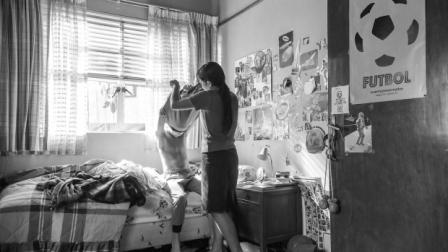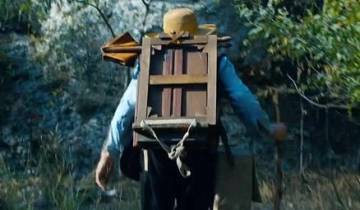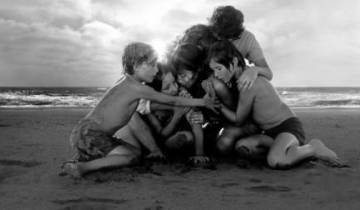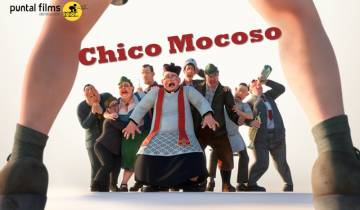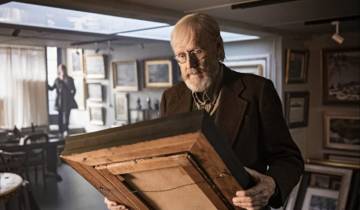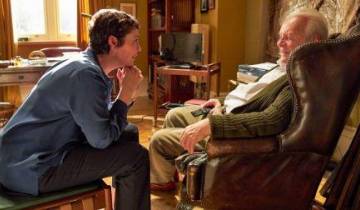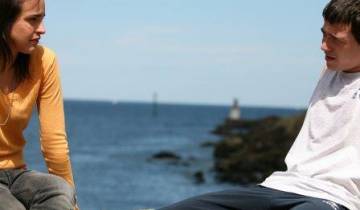
Roma
Original Title: Rome
Nationalities: Mexico, USA
Year of Production: 2018
Direction and Screenplay: Alfonso Cuarón
Cast: Yalitza Aparicio, Daniela Demesa, Marina de Tavira, Diego Cortina Autrey, Carlos Peralta.
Duration: 2h 15min

The film tells the story of an upper-middle class family living in the Roma neighborhood of Mexico City, in the early 1970s (between September 3, 1970 and June 28, 1971, to be exact). ). The family is made up of Sofía, the mother, who lives with her husband Antonio, her four young children and Sofía's mother, Teresa. Two maids, Cleo and Adela, live in a small room that overlooks the patio of the house. Both maids are of indigenous origin, Oaxacan, and speak both Spanish and their mother tongue, Mixteco. The camera observes the life of the family, cleaning the house, cooking, the children's way to school, bedtime and waking up, through Cleo's eyes. While all this is happening, it seems clear that Sofia and Antonio's marriage has entered a crisis.
Director Cuarón drew on his own childhood memories and the memories of Liboria "Libo" Rodríguez, the domestic worker who helped raise him and to whom he dedicated the film.
The symbology of the film is as rich as it is difficult to interpret, since it implies multiple readings, among them, the absence of a father figure, gender discrimination, the resilience of the indigenous population, the social division between rich and poor, political violence , cultural colonialism and references to cinema. Therefore, to better organize its analysis, we have chosen to divide it into themes:
Political Violence and Gender Discrimination
The year is 1970 when the story of "Roma" begins to unfold. In Mexico it was a year of presidential elections and that is why we must mention the two successive presidents, the outgoing and the incoming, in order to contextualize the events that occurred during the short period in which the story takes place.
Gustavo Díaz Ordaz served as president of Mexico from December 1, 1964 to November 30, 1970. He came from an upper-class family, distantly related to Porfirio Díaz. The outbreak and triumph of the Mexican Revolution left the Díaz Ordaz family in serious economic problems for having lost a large part of their properties. Despite the fact that the country enjoyed significant economic growth, with one of the lowest inflation levels in the history of Mexico (inflation was sustained at 2,7%), income inequality between the country's social classes and urban and rural environments, as well as unemployment levels, did not achieve significant improvements.
During his tenure, the largest international sporting events were held in Mexico: the 1968 Olympic Games and the 1970 World Cup (remember that in the children's room, in the film you can see a poster of the 1970 World Cup ).
The Díaz Ordaz government is infamous for having ordered the systematic repression of the Student Movement and for having organized the military operation known as Operation Galeana, which caused the so-called "Tlatelolco Massacre" on October 2, 1968. The president, along with his Secretary of Government, Luis Echeverría Álvarez, and Secretary of National Defense, Marcelino García Barragán, became intellectually responsible for the murder, detention, and disappearance of several hundred students. The Mexican army, the secret police and a paramilitary body called the Olimpia Battalion participated in Operation Galeana.
Díaz Ordaz gave false information to the United States Embassy in Mexico and to the United States Central Intelligence Agency (CIA), for which he was an informant. According to his version, the social and student movement would lead to a revolution with communist ideology, supported by the Soviet Union, Cuba and China. The Mexican government, with the complicity of the United States, implemented a media campaign to reinforce the idea of a "communist conspiracy" in the population, tending to justify large-scale repression. Since then, illegal arrests, torture, persecution, forced disappearances, espionage, criminalization of protests, homicides and extrajudicial executions have been carried out in order to extinguish the social movements that, from the presidency, were linked to international communism.
The Special Prosecutor for Social and Political Movements of the Past (FEMOSPP) created in 2002, says on page 24 regarding the events that occurred during the government of Díaz Ordaz: "The Mexican state characterized two sectors of the population, students and communists, as a problem of National Security and should, therefore, be treated with the same strategy of persecution and extermination."
On December 1, 1970, his secretary of government, Luis Echeverría Álvarez, succeeded Díaz Ordaz as president. A member of the Institutional Revolutionary Party (PRI), Echeverría Álvarez governed Mexico from 1970 to 1976. He was accused by the FEMOSPP and by the Mexican prosecutor's office of concocting, together with Gustavo Díaz Ordaz, the massacre of October 2, 1968 and the forced disappearance of dissidents in the context of the dirty war in Mexico, for which he became the first and only Mexican president to receive two arrest warrants for alleged genocide, serve house arrest and finally be acquitted of all responsibility in 2009. According to the book "'Inside the Company: CIA Diary' ("Inside the company: Diario de la CIA") by Philip B. Agee, Echeverría was a collaborator of the Central Intelligence Agency, like his predecessor Gustavo Díaz Ordaz.
During his government, more precisely on June 10, 1971, a demonstration of students from UNAM and the Polytechnic Institute took place, who marched to the Plaza de San Cosme in Mexico City, to show their support for the organic law, proposed by students from Monterrey, State of Nuevo León and their opposition to the educational reform. They also demanded the democratization of education, trade union democracy and the freedom of political prisoners. They were received by a paramilitary group called "Los Halcones" who fired at the crowd with high-caliber weapons, resulting in the death of more than one hundred students. That is why the episode was known as "El Halconazo", the Corpus Thursday Massacre or the Corpus Christi Massacre. The president publicly disclaimed all responsibility for the massacre.
The Corpus Thursday Massacre is the episode to which the film refers in one of its most powerful scenes. To understand her better, it is necessary to return to the story from a previous instance: Cleo is dating a young man named Fermín. During an outing with Adela and Ramón, Cleo and Fermín decide not to go to the movies and instead rent a hotel room. Fermín practices Kendo, a Japanese martial art. Naked he rolls out of bed, goes to the bathroom and grabs the shower rod to use as a kendo stick, bragging about his martial arts prowess to Cleo, who watches with visible admiration. At the end, his gun is pointed towards the bed and towards the camera, in such a way that the viewer associates it with an erect phallus.
The connotation of the weapon as a phallic symbol is then repeated in later sequences. In another outing, Cleo and Fermín meet at a cinema to see "La gran spree" ("La grande vadrouille", a 1966 British-French film, directed by Gérard Oury). The story takes place during the Second World War and is about three British pilots saved by French civilians from falling into the hands of the Nazis, who were then occupying the city of Paris militarily. The presence of airplanes is, in "Rome", linked to military interventions and processes of acculturation, with which I am inclined to interpret its symbology in this sense. But going back to the scene that concerns us, during the screening of "La gran revelry", Cleo tells Fermín that she is pregnant. Fermín stands her up in the projection room and disappears from her life. Once again an act of gender violence (and abandonment) unfolds associated with a scene of militarism as a backdrop (Oury's film).
Later, Cleo finds Fermín in a training center located in a slum on the outskirts of the city. The training of the paramilitary group was headed by Professor Zovek, a curious character who, in real history, was nicknamed the Mexican Houdini for his abilities with magic and escapism, and who used to appear disguised as a superhero from Marvel Comics. . As Zovec explains the training maneuvers, a plane streaks across the sky. Fermín refuses to recognize the baby and violently threatens Cleo with beating her and killing the baby, in case she returns to look for him.
Various interpretations can be inferred from this. In the first place, the same weapon that is used for political violence appears once again associated with gender violence; the place of training in an area of extreme poverty denotes that the government took advantage of the existing class inequality in the country, to attract young people from low social status and little education, with political objectives; and finally, Professor Zovek's superhero costume and the plane soaring through the sky right above his head bring to mind, by association, the connection to the United States and the CIA's support of the training and equipping of the United States. Halcones, with the supposed purpose of combating the communist ideology that, according to the ruling discourse, would have been taking over the university sphere and the press. The image and the initials LEA appear on the filming sites where the paramilitary group was training. In this way, director Cuarón makes his opinion clear about the responsibility for the events of then-president Luis Echeverría Álvarez.
This chain of symbols reaches its apogee in the sequence filmed on Avenida Ribera de San Cosme, where the Corpus Thursday massacre took place. A tracking shot shows us a heavily militarized society. Tanks, police cars and the avenue on which a furniture store is located appear in pictures. There we find Cleo and Doña Teresa choosing a crib for the baby that is about to be born. Suddenly, from the window we can see a subjective view of Cleo observing the demonstrators who start to run desperately because another group, which we have not yet seen, is chasing them to shoot them with firearms. The most successful thing about this sequence is that what initially appeared externally becomes close, penetrates the field of the private, in an area that seemed, until then, protected from danger. Three members of the paramilitary group "Los Halcones" enter the furniture store in search of a student who they finally shoot at close range in front of the frightened clients. An instant before leaving the room, one of them points his gun at Cleo, once again, as if to reinforce the association of the gun with the phallus. This is Fermin. Then, without a doubt, his participation in the paramilitary group Los Halcones, trained by the then Mexican government to repress student movements, is confirmed.
- Influence of Italian neorealism, especially "Open City Rome" (Roberto Rossellini, 1945), a story that takes place in Rome between 1943 and 1944, and is inspired by the life of the priest Luigi Morosini, tortured and killed by the Nazis for help resistance. Much of the filming of "Open City Rome" took place on real location and non-professional actors were hired for supporting roles. The movie was shot in black and white. In Cuarón's "Roma", black and white is an exclusively aesthetic choice, in order to highlight the nostalgic side of the past, but also as a way of paying homage to Italian neorealism. The theme of resistance against authoritarianism, as well as the preference for real locations and the hiring of non-professional actors, are also inspired by neorealism.
- "Amarcord" (1973) by the Italian director Federico Fellini, is a reference to the phonetic translation of the expression "a m'arcord" ("I remember"), used in the Emilia-Romagna region, where Fellini was from. native. "Amarcord" has autobiographical overtones. Through the eyes of Titta's character, Fellini revisits his family life, religion, education, and politics in the 30s in Italy, during the fascist period. He also talks about the dreams fueled by the cinema, by a transatlantic that passes by and by tourists in a luxury hotel. In the Mexican film, cinema also becomes a form of escapism in the face of cruel reality, and the planes, like Fellini's ships and tourists, synthesize the futility of human life and the passage of time.
- In one of the scenes, the children go to see, accompanied by Cleo, the science fiction film "Abandoned in Space" ("Marooned", John Sturges, 1969), one of the director's favorite films and which served as a reference for "Gravity" (Alfonso Cuarón, 2013).
- The movie that Cleo and Fermín are going to see is "La gran revelry" ("La grande vadrouille", a 1966 British-French film, directed by Gérard Oury). It is striking how the director managed to make the rows of seats inside the screen seem to continue in the space of our own movie theater.
- Cuarón refers to his own cinema. The childbirth scene is similar to the one that occurs in "Hijos de los Hombres" (Alfonso Cuarón, 2006) and the scene in which the mother reveals to her children, in an ice cream parlor near the beach, that their father has abandoned them , is similar to one of "And your mother too" (Alfonso Cuarón, 2001).
- The remembrance of Cantinflas on black and white TV in Mexico in the '70s. In addition, the AM portable radio was a constant company in homes and here it enhances the memory of the childhood stage.
- Cuarón uses the window frames as a cinematographic frame. He recurrently places the camera inside the house to film what is happening in the patio, in the background, and leaves the window frame in the foreground. This form of framing also refers to the cinema within the cinema.
Locations
Regarding the filming locations, Cuarón's idea was that of a complete and exhaustive recreation of the interior of his birthplace and the surroundings of Mexico in the '70s. The art director of "Roma" is Eugenio Caballero, winner of an Oscar for Best Art Direction for "Pan's Labyrinth" (Guillermo del Toro, 2006).
The family house was originally located at number 21 Tepeji street, a building built in the 1930s, but since it was so modified, it became impossible to shoot there. Then the production team found a similar house, which was unoccupied, in the Narvarte neighborhood, and there they were able to film comfortably. The exterior scenes, in which we can see the facades, were made on Tepeji street but in the neighboring houses with different numbers. In addition, some buildings that collapsed during the 1985 Mexico earthquake were added through visual effects.
To recreate what the Cuarón family house looked like, Eugenio Caballero followed the director's own memories and some family photographs. For the interiors, 80% of the furniture that the family still had was integrated, and furniture and objects were searched in five states of Mexico and among the production itself.
The garage seen in the film had to be recreated in the style of the time and for this a craftsman placed the mosaics of the patio and the bathroom with the same technique used then.
Given the changes in the appearance of the Mexican capital, the production needed to build a large set to recreate the family's trip to the old Las Américas cinema and the scene in which Sofía takes Cleo to the hospital. In a space north of the Mexican capital, a film set was created that reproduced two and a half blocks of the city, including access to Cine Las Américas, asphalt, sidewalks, furniture, and vehicles from the XNUMXs and XNUMXs. The backgrounds were added with the chroma key technique. The visual effects team did a painstaking reconstruction of the period setting, adding buildings, fluorescent billboards, and even the same background perspective avenues.
The filming of the Corpus Thursday Massacre was carried out with dozens of extras in the exact place where the events occurred, on the Mexico-Tacuba road and Tláloc and Lauro Aguirre streets. For this, a documentary investigation was used that included newspapers of the time and testimonies of survivors. The area was completely closed for two days, after which the production apologized to the population for the inconvenience caused.
Sound Effects and Songs
It was important to Cuarón that some of the sounds he remembered from the Mexico of his childhood in the XNUMXs be faithfully recorded and mixed. For this he hired Sergio Díaz, who included incidental sounds from the soundscape of that time. These sounds included:
- The cry of beehive honey sellers
- The shawm or sharpener's whistle
- The bell with which the passage of the waste truck was announced
- The sound of the steam whistle of the sweet potato and banana vendor carts
- The cries of street vendors
- The sound of the broom sweeping the sidewalk
- The sound of water washing the patio of the house
- The sound of military bands
- Likewise, radio sounds were included, such as jingles and vintage radio advertisements that were broadcast by Radio Variedades, Radio Éxitos and La Pantera.
In the film, in addition, the following songs were included:
- I promised you", Leo Dan, 1969
- "More beautiful than any", Rocío Durcal, 1965
- I have no money", Juan Gabriel, 1971
- "Little Black Angels", The Green Cakes, 1974
- "The ship of oblivion", José José, 1970
- "Thank you", Rigo Tovar, 1972
- "The Wanderer", Álvaro Carrillo
- "The dancing pachuco", Dámaso Pérez Prado orchestra, 1978
- "Shadows", Javier Solis, 1965
- "Veronica", Victor Yturbe "El Lollipop"
- "Yellow River", Christie, 1970
- I don't know how to love him, Yvone Elliman, 1970
- "Heart of Melon", Dámaso Pérez Prado's orchestra
- "Pancha's eyes", Chicontepec trio
- Mammy Blue, Roger Whittaker, 1971
- "Borincano Lament", Daniel Santos, 1978
- "The lover I dreamed of", The Earthlings, 1972
- "You tell me you're leaving", Carmela and Rafael
- "Those Were the Days", Ray Coniff
- "Honey", The Baby's
- "The Isabeles", Luis Pérez Meza, 1949
- "The beautiful Indian", Luis Pérez Meza
- "Zacazonapan", Band Dragons of Zacatepec
- "The House of the Rising Sun", Javier Bátiz
- "Lost City", The Revolution of Emiliano Zapata, 1971
- "Come on (and come on)", The little pearls
- "Let's talk", The rhythm partners, 1971
- "My heart is a gypsy", Lupita D'Alessio, 1971
- "When I fall in love", Angelica Maria, 1968
- "Sea and foam", tropical Acapulco
- "The mother-in-law", The Strwch, 1970
Adriana Schmorak Leijnse
Bibliography
"The Malinche" on Wikipedia
"Rome Open City" on Wikipedia
Stroza, Pablo. "Rome. Why the Netflix movie must be seen in the cinema". Published in Border Journalism, December 12, 2018.
"'Roma', the portrait of Mexico from 1970, arrives in Venice", in Millennium, published on August 30, 2018
"Roma, da Netflix: five questions to understand or acclaimed film by Alfonso Cuarón", BBC News Brazil, December 19, 2018.
Rovar, Erick. "Nostalgia and Viking Mysticism in Cuarón's 'Roma'" in Hidden Cinema, December 29, 2018
"Rome (2018 film)" on Wikipedia
"Luis Echeverría Álvarez" on Wikipedia
"Gustavo Díaz Ordaz" on Wikipedia
